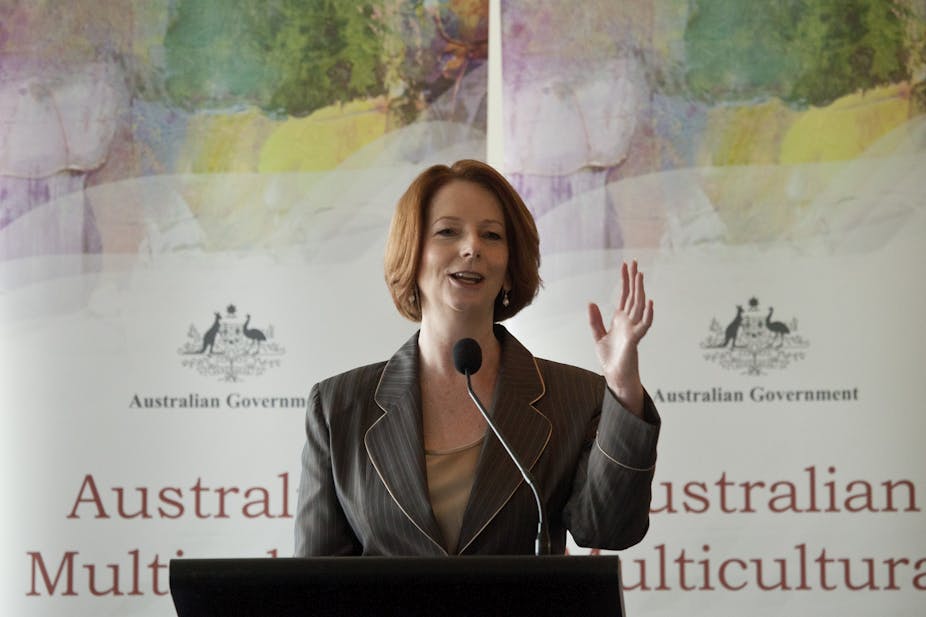Multiculturalism may not be flavour of the month, but the launch by Prime Minister Gillard on Monday of the Australian Multicultural Council (AMC) marks a step forward in a policy project restarted by PM Rudd in 2008.
The Howard government allowed its Multicultural Council to die out gracefully in 2006, succumbing to the departure of its sole in-house champion Arthur Sinodinos from the then PM’s office. In her launch speech Gillard insisted that multiculturalism was about early rising and hard work, in a patchwork economy.
The AMC has both symbolic and practical roles, increasingly important for a government that believed its ethnic vote was rusted on, and found in NSW and Victoria that it had slipped away in droves.
The most important symbolism lies in what is revealed about the government’s understanding of and commitment to a multicultural agenda, and how it is read by the many stakeholder groups it has to convince.
The Council is already encumbered by the low profile feel-good terms of reference it was given by its immediate Advisory predecessor in the Australian Multicultural Advisory Council (many of whose members re-appear), and despite the claim that the Council is independent, two key functionaries are ex-officio members – Immigration Department Secretary Andrew Metcalfe, and the new Race Discrimination Commissioner Helen Szoke. (For a full list of members see here)
Who is on the Council?
The chair is well-respected South Australian Judge Rauf Soulio, with key possibly political appointments including Whitlam Institute member Talal Yassine, Peter Wertheim from the Jewish community, and one each from the Fairfax and Murdoch opinion pages psychiatrist Tanveer Ahmed and philosopher Tim Soutphommasane.
Soulio’s tight team has an extensive profile in relation to Muslim and Islamic issues, but surprisingly there is no reflection of the strong Chinese presence in Australia (a possible payback for the Chinese switch to the Liberal Party in NSW?), and the historic Greek role in Australian multiculturalism has been removed (perhaps payback for the switch to Liberals in Victoria).
Importantly, despite the anti-racism role, the Council will not have any Indigenous participation (unlike the SBS Board). The territories and Tasmania are also excluded.
Challenges for the AMC
The Council has three major challenges: rebuilding and advancing the access and equity dimensions of the social justice strategy of government within the bureaucracy and more widely; advising on the anti-racism strategy announced by the government in February; and determining research priorities in cultural diversity.
It is somewhat hamstrung in achieving these goals, as despite its independence it does not appear to have its own budget for projects.
Moreover in relation to access and equity, the Council does not have strong legislated powers, a conscious consequence of its predecessor AMAC and the government choosing not to advance an Australian Multiculturalism Act. This was last recommended in 1989 and supported at that time by Hawke but ditched by Keating.
This problem was intensified when the government refused to produce a Human Rights Act. So with no real powers, and no resources, it will be fighting an interesting battle from the bottom of the food chain in Cabinet to gain purchase on a potentially recalcitrant and conservative public service and a swatch of ministers who believe that the “punters” think multiculturalism means Muslims.
Fighting against racism
The anti-racism strategy carries a small budget line, secured in inter-bureaucratic wrangling by the Human Rights Commission from its competitor in the Department of Immigration and Citizenship (DIAC). DIAC has sought to keep the strategy close to its chest, but it will now need to open out.
The Council has limited expertise in this specific area, which will require confidence to take on the major media and public institutions where racism festers. In the past governments have avoided the media tycoons and their practices of exclusion and racism, hampered by another conscious government decision to reject the criminalisation of hate speech (except in Western Australia).
Recent government statements denying racism in the Indian student attacks in Victoria do not stimulate confidence.
Lack of research
For the academic and policy community the research role is critical: Australia has closed down and all but lost its former research capacity in this area, which has to be rebuilt.
AMAC had refused to recommend re-establishing a central research institute. The new Council has limited expertise in large-scale empirical research required, for instance, to underpin the Social Inclusion strategy (which has significantly failed in this area) and will be unlikely to have a research unit of its own.
It has no resources to contract research and DIAC’s own research budget is miniscule, policy focused and often politically directed.
This is an area that must be addressed if Australian multicultural policy is to advance.

